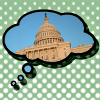Page 28 of the Obama administration’s blueprint for rewriting No Child Left Behind, released earlier this month, contains a vague but interesting paragraph about ensuring that American students have a “well-rounded education.” The plan would provide grants to states and school districts to bolster the teaching of arts, foreign languages, history, civics and something called “environmental education.”
Patrick Fitzgerald, the director of education advocacy for the National Wildlife Federation, could not think of another time when environmental literacy has been explicitly broached in reauthorization of the Elementary and Secondary Education Act. And so the mention, albeit a brief one in an early-stage blueprint, is a big deal for advocates who worry children are spending dramatically less time around nature at precisely the moment when environmental crises demand a basic understanding of everything from the carbon cycle to the recycling process.
As the Department of Education’s broad-brush outline gets translated in the coming months into specific legislative language, many environmental groups hope it will include the No Child Left Inside Act. Critics wary of environmental demagoguery should take note: The act includes no mandates, only incentives.
Science education has become a politically hot topic, with several states and school boards recently adopting or considering requirements that teachers emphasize “uncertainty” around climate change and evolution. No Child Left Inside is not about dictating this curriculum dispute (and the bill, Fitzgerald points out, has both Republican and Democratic co-sponsors).

Miller-McCune’s Washington correspondent Emily Badger follows the ideas informing, explaining and influencing government, from the local think tank circuit to academic research that shapes D.C. policy from afar.
“Environmental education is really about teaching kids how to think,” Fitzgerald said, “not what to think.”
He stresses the benefits of learning about nature — and directly in nature — not just for environmental literacy, but also for the success of students across other subject areas. A number of studies have suggested that students who receive environmental education have higher standardized test scores, better grades in reading, writing and math, and improved behavior and critical thinking skills.
One study, conducted in 2004 by the Pacific Education Institute and requested by the Washington state Legislature, analyzed more than 150 schools in the state, half with environmental education integrated across age groups and curriculum, and half with no such education. Students in the first group performed better on standardized tests, improved their GPAs and were more likely to stay in school longer.
No Child Left Inside would similarly encourage integrating environmental education across existing subjects. This would counteract an opposite trend since the 2001 passage of No Child Left Behind, which pushed many subjects out of the classroom as teachers focused on preparing for reading and math standardized tests.
“We’re not trying to get schools to create a fifth-period environmental education class,” Fitzgerald said. “It’s more around training teachers, getting them to understand how to use the environment and the outdoors in educating kids.”
The bill, like the Obama blueprint, would do this by providing grants to educate teachers and develop curriculum.
Another set of studies portrays a grim picture of what Americans — children and adults — currently know about the environment. Most of us, for starters, think we know more than we actually do. A 2005 report from the National Environmental Education Foundation concluded that only 12 percent of Americans could pass a basic quiz on energy topics.
Equally discouraging: 45 million Americans think fresh water comes from the ocean; 120 million think chlorofluorocarbons are still contained in spray cans (they haven’t been since 1978); and 130 million think America gets most of its energy from hydropower.
This leaves an awful lot of ground to cover before we ever even get to the part about anthropogenic climate change.
“We do know that kids are spending just seven minutes a day outdoors currently compared to over seven hours in front of a screen,” Fitzgerald said. “Generally, this contact with nature, this time outdoors, whether it’s after school or in school, is just not happening. The connection to nature in that sense is dwindling quite rapidly.”




